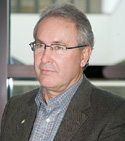 . PCL�s Grieve says diversification was defensive, but no markets slumped and profits soared.
|
In addition to Ernest Poole, PCL has been influenced by an older company that is almost its spiritual cousin. PCL’s disciplined approach to contracting, flush balance sheet and desire to hire you for a career, not a job, reminds many of Kiewit Corp., Omaha, Neb. The two companies seem to be made of minerals extracted from the same Western soil. They have had joint ventures, and they are linked by their mutual interest in Alberta’s natural resources, where Kiewit and PCL find plenty of work.
In PCL’s corporate autobiography, published on the company’s 100th anniversary in 2006, PCL treats Kiewit with special respect. In the 1940s, Kiewit approached PCL to become a joint-venture partner, and the two pursued heavy civil projects such as the Banff-Jasper highway through the Rockies. PCL’s book calls Kiewit “a leader in labor relations...recognized for setting a fine example for the Poole organization.”
|
Ross Grieve, PCL Construction Group’s chief executive, recalls many years ago travelling to Kiewit’s headquarters to visit. “I felt lucky to have done it,” he says. “I got to meet with Walter Scott, Bruce Grewcock [and other top executives]. They were very nice and courteous and talked about opportunities.”
As a shadow now passes over the U.S. economy, a critical difference separates the two companies, both of which have offices across the U.S. and Canada. PCL is diversified but heavily dependent on buildings, which accounted for $3.55 billion of PCL’s record 2007 revenue of $5.07 billion. Kiewit’s core consists primarily of transportation infrastructure and mining. That could mean PCL’s future bookings and to some extent its backlog are more vulnerable than Kiewit’s if financial and credit markets continue to deteriorate.
 Michael Goodman / ENR Oil sands-related projects could keep PCL warm in buildings slump.
|
The booming petrochemical work in Alberta could keep PCL growing, although probably not as fast as the pace of the past few years when, as Grieve points out, “none of our markets dropped off.”
Long before $100-a-barrel oil, PCL set out to increase its energy and industrial work with acquisitions in the U.S. It also built its portfolio in northern Alberta, where oil sands stretch out over thousands of square miles. Grieve sees the oil sands (the second-largest petroleum reserve in the world, but one of the costliest to extract) as key to the future of PCL and Alberta. Peter Stalenhoef, PCL’s heavy-industry unit president, says the value of work his unit performs in Alberta is “almost all oil sands.”
Overall, PCL’s industrial and energy-related revenue in 2007 came to about $650 million in Canada and $100 million in the U.S.
 |
| STALENHOEF |
Some Albertans already tend to see their province as Texas North and the sprawling oil sands as a fossil-fuel El Dorado. “Calgary is Dallas and Edmonton is Houston,” suggests a PCL staffer.
To be sure, Canada and Alberta have given the oil industry broad leeway to develop the reserves, and Edmonton has prospered with it. Energy experts predict that oil coming from Canada will compete with smaller, hard-to-reach reserves in the Gulf of Mexico and other places around the globe.
But it remains to be seen whether the oil sands will fulfill some of the pulse-quickening expectations and propel PCL more deeply into industrial contracting. Even with the huge pile of cash the company has to work with, including $120 million added to working capital in fiscal 2006, expansion may be limited by a shortage of skilled workers.
 PCL
|
Building Up
PCL grew with buildings work of all kinds but now sticks to the premium end. PCL’s predecessor company was founded in 1906 in Saskatchewan, and the company still sends staff members to that province to develop their skills. But PCL’s major expansion in buildings came with work for Oxford Development Group, which had projects all over Canada and the U.S., as well as a rapidly developing Denver in the 1970s, where its U.S. headquarters is today. In 1980, PCL began building the vast West Edmonton Mall for another developer. Much of downtown Edmonton and major structures across Canada fill the contractor’s resume.
 PCL PCL Placed Concrete at an Orlando Tower (above) and Seattle Light Rail (below right) but subbed Toronto office (above right)
|
General contracting on buildings projects can be a very low-profit enterprise. “Why mess around in that low-margin world?” a Kiewit executive once asked someone at PCL.
“We’re not in that business,” answers Peter E. Beaupré, president of PCL Construction Enterprises and the executive whose unit built up PCL’s U.S. buildings revenue. Much of the new buildings work is negotiated, not bid. “We’re not in the 3%-to- 5% profit land in U.S. buildings because we’re a general,” says Beaupré, He contrasts PCL with Turner Construction, New York City. “Even though Turner might call itself a general contractor, it is more of a construction manager, and the margin is tiny. It is pass-through brokered with no staff or craft. You take on price risk and subcontractor performance,” says Beaupré. “We don’t get into that business stream.” PCL performs its own concrete work in the U.S. but has subcontractors erect steel.
 PCL |
In Canada, PCL has fewer competitors in the buildings market’s upper tier. Canadians are ahead of the U.S. in using public-private partnerships, which plays into PCL’s hands. As for the current credit crunch and qualms about a recession, Paul G. Douglas, president of the Canadian building unit, says, “Owners and financiers in Canada are watching the current situation and are cautious, but there have been no project cancellations, and new projects in the preconstruction stages continue to move forward.”
No Nukes
PCL’s discipline of taking only profitable work with manageable risk extends into all markets. PCL will not construct nuclear powerplants, and the company never warmed up to the idea of expanding into the northeastern U.S., partly because the executives believe the company’s “Western” style won’t work there. And other than building in the Caribbean, PCL sticks to North America.
Hugh Rice, chairman of Raleigh, N.C.-based consultant FMI, which has worked for PCL, says the company is similar to Kiewit in refusing to work cheaply. “They won’t do high-risk stuff and refuse to work on riskier projects on a lump-sum basis,” he says. PCL prefers that risk be allocated to the project player best equipped to manage it and be priced so that those who take it and manage it are rewarded, say company executives.
On this bedrock of fundamentals, PCL’s recent financial performance has been remarkable. For all of fiscal 2007, PCL reported revenue of $5.07 billion, up from $4.2 billion in fiscal 2006, and profit before taxes of $308.7 million, up...
here is an old beige handwritten note framed under glass in a prominent place in one of PCL Construction Group’s Edmonton Canada, buildings. Written by Ernest Poole in 1948 when he sold what became PCL to his sons, the document is part of a deliberate attempt to keep the company’s history and culture front and center. In PCL’s case,Poole’s Rules, as the document is called, still govern to some extent how Canada’s largest contractor will risk its money and reputation. In this way, Poole still rules. Related Links:
Related Links: 